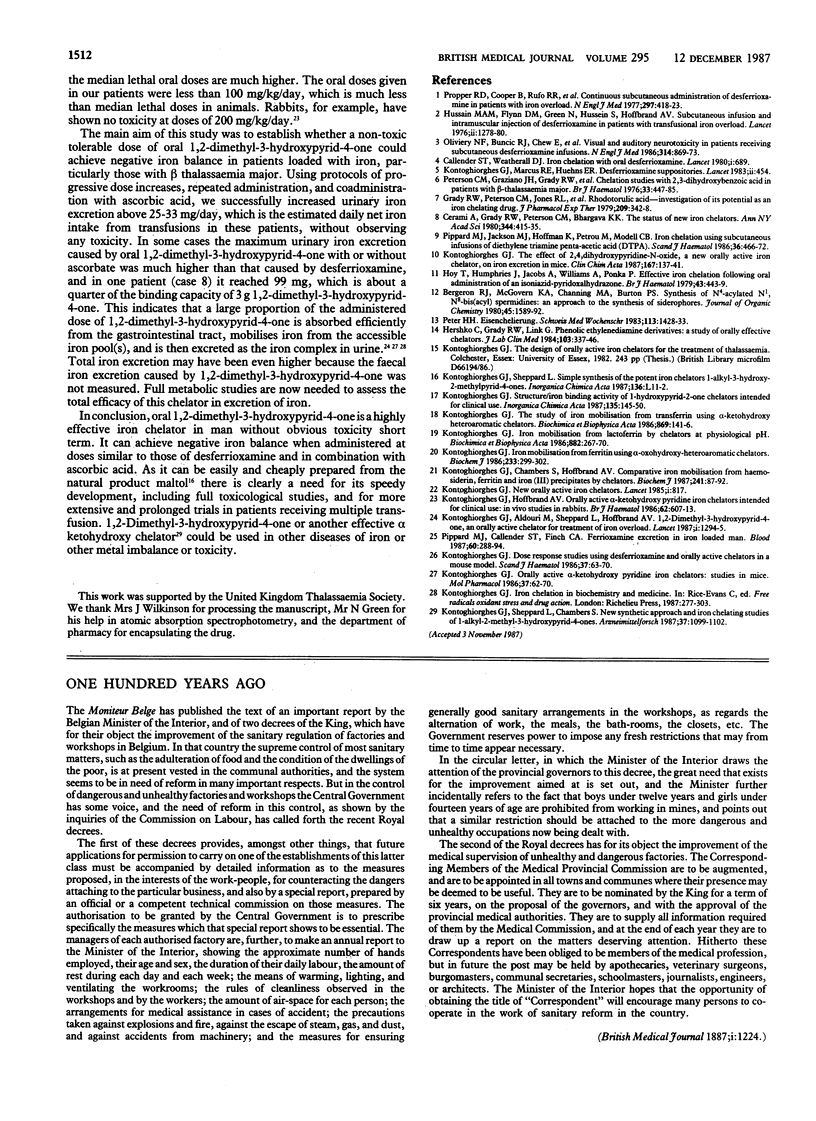Abstract
The main iron chelator used for transfusional iron overload is desferrioxamine, which is expensive, has toxic side effects, and has to be given subcutaneously. An orally active iron chelator is therefore required. The effects of oral 1,2-dimethyl-3-hydroxypyrid-4-one on urinary iron excretion were studied in eight patients who had received multiple transfusions: four had myelodysplasia and four beta thalassaemia major. Different daily doses of the drug up to 100 mg/kg/day, alone or in combination with ascorbic acid, were used. In three patients with thalassaemia the effect of the drug was compared with that of subcutaneous desferrioxamine at the same daily dose. In all eight patients a single dose of oral 1,2-dimethyl-3-hydroxypyrid-4-one resulted in substantial urinary iron excretion, mainly in the first 12 hours. Urinary iron excretion increased with the dose and with the degree of iron loading of the patient. Giving two or three divided doses over 24 hours resulted in higher urinary iron excretion than a single dose of the same amount over the same time. In most patients coadministration of oral ascorbic acid further increased urinary iron excretion. 1,2-Dimethyl-3-hydroxypyrid-4-one caused similar iron excretion to that achieved with subcutaneous desferrioxamine at a comparable dose. In some cases the iron excretion was sufficiently high (maximum 99 mg/day) to suggest that a negative iron balance could be easily achieved with these protocols in patients receiving regular transfusions. No evidence of toxicity was observed on thorough clinical examination or haematological and biochemical testing in any of the patients. None of the patients had any symptoms that could be ascribed to the drug. These results suggest that the oral chelator 1,2-dimethyl-3-hydroxypyrid-4-one is as effective as subcutaneous desferrioxamine in increasing urinary iron excretion in patients loaded with iron. Its cheap synthesis, oral activity, and lack of obvious toxicity at effective doses suggest that it should be developed quickly and thoroughly tested for the management of transfusional iron overload.
Full text
PDF



Selected References
These references are in PubMed. This may not be the complete list of references from this article.
- Callender S. T., Weatherall D. J. Iron chelation with oral desferrioxamine. Lancet. 1980 Sep 27;2(8196):689–689. doi: 10.1016/s0140-6736(80)92721-x. [DOI] [PubMed] [Google Scholar]
- Grady R. W., Peterson C. M., Jones R. L., Graziano J. H., Bhargava K. K., Berdoukas V. A., Kokkini G., Loukopoulos D., Cerami A. Rhodotorulic acid--investigation of its potential as an iron-chelating drug. J Pharmacol Exp Ther. 1979 Jun;209(3):342–348. [PubMed] [Google Scholar]
- Hershko C., Grady R. W., Link G. Phenolic ethylenediamine derivatives: a study of orally effective iron chelators. J Lab Clin Med. 1984 Mar;103(3):337–346. [PubMed] [Google Scholar]
- Hoy T., Humphrys J., Jacobs A., Williams A., Ponka P. Effective iron chelation following oral administration of an isoniazid-pyridoxal hydrazone. Br J Haematol. 1979 Nov;43(3):443–449. doi: 10.1111/j.1365-2141.1979.tb03771.x. [DOI] [PubMed] [Google Scholar]
- Hussain M. A., Green N., Flynn D. M., Hussein S., Hoffbrand A. V. Subcutaneous infusion and intramuscular injection of desferrioxamine in patients with transfusional iron overload. Lancet. 1976 Dec 11;2(7998):1278–1280. doi: 10.1016/s0140-6736(76)92035-3. [DOI] [PubMed] [Google Scholar]
- Kontoghiorghes G. J., Aldouri M. A., Sheppard L., Hoffbrand A. V. 1,2-Dimethyl-3-hydroxypyrid-4-one, an orally active chelator for treatment of iron overload. Lancet. 1987 Jun 6;1(8545):1294–1295. doi: 10.1016/s0140-6736(87)90545-9. [DOI] [PubMed] [Google Scholar]
- Kontoghiorghes G. J., Chambers S., Hoffbrand A. V. Comparative study of iron mobilization from haemosiderin, ferritin and iron(III) precipitates by chelators. Biochem J. 1987 Jan 1;241(1):87–92. doi: 10.1042/bj2410087. [DOI] [PMC free article] [PubMed] [Google Scholar]
- Kontoghiorghes G. J. Dose response studies using desferrioxamine and orally active chelators in a mouse model. Scand J Haematol. 1986 Jul;37(1):63–70. doi: 10.1111/j.1600-0609.1986.tb01773.x. [DOI] [PubMed] [Google Scholar]
- Kontoghiorghes G. J., Hoffbrand A. V. Orally active alpha-ketohydroxy pyridine iron chelators intended for clinical use: in vivo studies in rabbits. Br J Haematol. 1986 Apr;62(4):607–613. doi: 10.1111/j.1365-2141.1986.tb04082.x. [DOI] [PubMed] [Google Scholar]
- Kontoghiorghes G. J. Iron mobilisation from lactoferrin by chelators at physiological pH. Biochim Biophys Acta. 1986 Jun 19;882(2):267–270. doi: 10.1016/0304-4165(86)90164-9. [DOI] [PubMed] [Google Scholar]
- Kontoghiorghes G. J. Iron mobilization from ferritin using alpha-oxohydroxy heteroaromatic chelators. Biochem J. 1986 Jan 1;233(1):299–302. doi: 10.1042/bj2330299. [DOI] [PMC free article] [PubMed] [Google Scholar]
- Kontoghiorghes G. J. New orally active iron chelators. Lancet. 1985 Apr 6;1(8432):817–817. doi: 10.1016/s0140-6736(85)91472-2. [DOI] [PubMed] [Google Scholar]
- Kontoghiorghes G. J., Sheppard L., Chambers S. New synthetic approach and iron chelating studies of 1-alkyl-2-methyl-3-hydroxypyrid-4-ones. Arzneimittelforschung. 1987 Oct;37(10):1099–1102. [PubMed] [Google Scholar]
- Kontoghiorghes G. J. The study of iron mobilisation from transferrin using alpha-ketohydroxy heteroaromatic chelators. Biochim Biophys Acta. 1986 Jan 30;869(2):141–146. doi: 10.1016/0167-4838(86)90288-8. [DOI] [PubMed] [Google Scholar]
- Kontoghiorghes G., Marcus R. E., Huehns E. R. Desferrioxamine suppositories. Lancet. 1983 Aug 20;2(8347):454–454. doi: 10.1016/s0140-6736(83)90413-0. [DOI] [PubMed] [Google Scholar]
- Olivieri N. F., Buncic J. R., Chew E., Gallant T., Harrison R. V., Keenan N., Logan W., Mitchell D., Ricci G., Skarf B. Visual and auditory neurotoxicity in patients receiving subcutaneous deferoxamine infusions. N Engl J Med. 1986 Apr 3;314(14):869–873. doi: 10.1056/NEJM198604033141402. [DOI] [PubMed] [Google Scholar]
- Peter H. H. Eisenchelierung. Biologische Bedeutung und medizinische Anwendungen. Schweiz Med Wochenschr. 1983 Oct 8;113(40):1428–1433. [PubMed] [Google Scholar]
- Pippard M. J., Callender S. T., Finch C. A. Ferrioxamine excretion in iron-loaded man. Blood. 1982 Aug;60(2):288–294. [PubMed] [Google Scholar]
- Pippard M. J., Jackson M. J., Hoffman K., Petrou M., Modell C. B. Iron chelation using subcutaneous infusions of diethylene triamine penta-acetic acid (DTPA). Scand J Haematol. 1986 May;36(5):466–472. doi: 10.1111/j.1600-0609.1986.tb02282.x. [DOI] [PubMed] [Google Scholar]
- Propper R. D., Cooper B., Rufo R. R., Nienhuis A. W., Anderson W. F., Bunn H. F., Rosenthal A., Nathan D. G. Continuous subcutaenous administration of deferoxamine in patients with iron overload. N Engl J Med. 1977 Aug 25;297(8):418–423. doi: 10.1056/NEJM197708252970804. [DOI] [PubMed] [Google Scholar]


